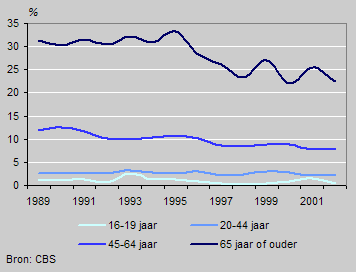One in five elderly have mobility problems

The percentage of people with serious restrictions in mobility has fallen in the last decade. Relatively many elderly people use aids to get around. The results of this study do not include elderly people living in homes and institutions.
Fewer restrictions in mobility
In spite of the ageing population, the percentage of people with serious mobility restrictions fell from 9 in 1989 to 7 in 2002. The decrease is largest among the elderly.
Restrictions in mobility by age, 1989-2002

The most serious problems with mobility still occur among the elderly, however: one in ten people aged 65 to 74 years had serious problems getting around in 2001-2002. In the group over 75 years of age this rose to two in ten.
Older women have more mobility problems than older men. One quarter of elderly women aged 75 years or older have serious problems getting around. This is twice the percentage of men in this age group.
Aids for four out of ten older women
From the age of fifty-five more people use a walking stick, crutch, or walker to get around. Women in this age group are twice as likely to use such an aid as men.
Use of walking aids, 2001-2002

One in every hundred of the Dutch population uses an invalid carriage or wheelchair. For people aged 65 to 74 years, 2 percent uses these aids, while some 6 percent of over-75s depend on them.
Four out of ten women aged 75 years and older use a walking aid or an invalid carriage or wheelchair; for men in this age group this is two out of ten.
Unhappier and fewer contacts
People with serious limitations in mobility are less likely to feel happy and content and have fewer social contacts. They are three times as likely to be unhappy and dissatisfied with life than people without mobility problems.
Feelings of well-being and social contacts by mobility problems, 2002

People with serious mobility problems also have considerably fewer contacts with both family and friends than people without these problems.
Ferdy Otten
Source: StatLine (Dutch only)